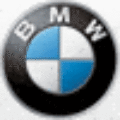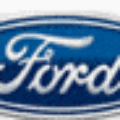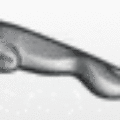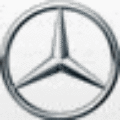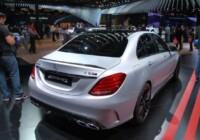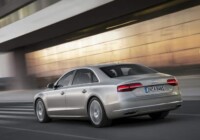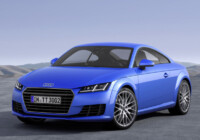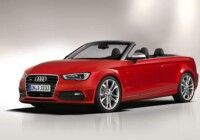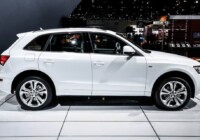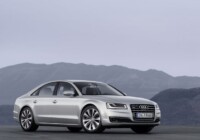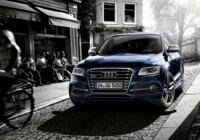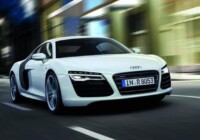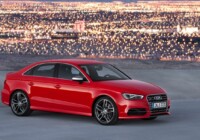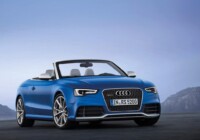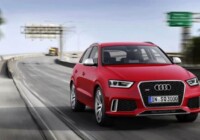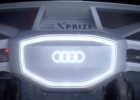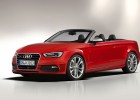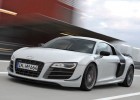Audi
AUDI: Expert reviews and news
AUDI designs, engineers, manufactures and distributes automobiles and motorcycles. Audi oversees worldwide operations from its headquarters in Ingolstadt, Bavaria, Germany. Audi-branded vehicles are produced in seven production facilities worldwide.
Audi has been a majority owned (99.55%) subsidiary of Volkswagen Group since 1966, following a phased purchase of AUDI AG’s predecessor, Auto Union, from Daimler-Benz. Volkswagen relaunched the Audi brand with the 1965 introduction of the Audi F103 series.
The company name is based on the surname of the founder, August Horch. “Horch”, meaning “listen”, becomes “Audi” when translated into Latin. The four rings of the Audi logo each represent one of four car companies that banded together to create the company. Audi’s slogan is Vorsprung durch Technik, meaning “Advancement through Technology”. Recently in the United States, Audi has updated the slogan to “Truth in Engineering”.
Audi is part of the “German Big 3” luxury automakers, along with BMW and Mercedes-Benz, which are the three best-selling luxury automakers in the world.
Here are the most attractive models made by Audi
Audi S3 and S3
The new Audi S3 and the new S3 offer superior performance and groundbreaking efficiency. Their 2.0 TFSI engine produces 221 kW (300 hp) and 380 Nm (280,27 lb-ft) of torque. The high-performance four-cylinder unit combines cutting-edge technologies such as dual injection, the exhaust manifold integrated into the cylinder head, the Audi valvelift system and the rotary valve module for the thermal management system.
When equipped with the optional six-speed S tronic, the sprint from 0 to 100 km/h (62.14 mph) takes just 4.8 seconds ( : 4.9 seconds), with each model requiring four-tenths of a second more when equipped with the six-speed manual. Top speed is restricted to 250 km/h. The sonorous, turbocharged four-cylinder engine consumes on average 6.9 liters of fuel per 100 kilometers with the S tronic and 7.0 liters with the manual transmission (34.09/33.60 US mpg, respectively). Compared with the previous model equipped with a manual transmission, this represents a decrease of 1.5 liters per 100 kilometers. A newly developed multi-plate clutch in the quattro drivetrain controls the flow of power to the front and rear axles.
A key factor for the dynamic performance of the premium compact model is its lightweight construction. The Audi S3 has a curb weight of just 1,395 kilograms (3,075.45 lb), the S3 1,445 kilograms (3,185.68 lb) – easily the best in the segment. Compared with the previous model, the weight has been reduced by 60 kilograms and 70 kilograms (132.28 lb and 154.32 lb), respectively, with the body accounting for a large portion of this. Ultra high-strength steels plus the aluminum front fenders and engine hood play a role here.
The sport suspension lowers the vehicle body by 25 millimeters (0.98 in). Mounted behind the light-weight, 18-inch wheels are large brakes. The ESC intervenes with particularly sensitivity. The new electronically-assisted, progressive power steering varies the steering ratio. It is somewhat more indirect around the center and very direct when steered sharply. Audi drive select is standard, with Audi magnetic ride available as an option.
Audi S4 and Audi S4 Avant
The supercharged 3.0 TFSI in the Audi S4 and S4 Avant provides for superior power delivery. The V6 combines 245 kW (333 hp) of power and 440 Nm (324.53 lb-ft) of torque with a fuel consumption of just 8.1 liters of fuel per 100 kilometers (29.04 US mpg) or 8.4 liters per 100 kilometers (28.00 US mpg) in the Avant. The sedan sprints from 0 to 100 km/h (62.14 mph) in 5.0 seconds; the Avant in 5.1 seconds.
Both models come standard with the seven-speed S tronic. The sport suspension lowers the vehicle body by 20 millimeters (0.79 in), and the high-performance brake system provides powerful deceleration.
The wheels are 18 inches in diameter. Among the special options are Audi drive select, damper control and dynamic steering.
Audi S5 , S5 Coupé and S5 Cabriolet
The 3.0 TFSI with 245 kW (333 hp) and 440 Nm (324.53 lb-ft) is also used in the S5 model series – in the S5 , S5 Coupé and S5 Cabriolet. Performance is superior: The S5 Coupé races from zero to 100 km/h (62.14 mph) in just 4.9 seconds. Fuel consumption is just 8.1 liters per 100 kilometers (29.04 US mpg) on average.
A seven-speed S tronic is standard with all three S models. The tautly tuned S sport suspension is also aided by electronically controlled shock absorbers and dynamic steering. Both of these optional systems can be integrated into the optional Audi drive select. The S models roll on 18-inch aluminum wheels.
Audi S6 and Audi S6 Avant
The Audi S6 and the S6 Avant are sports cars for everyday. Their twin-turbo V8 engine, the 4.0 TFSI, generates 309 kW (420 hp) and 550 Nm (405.66 lb-ft) of torque. The S6 accelerates from 0 to 100 km/h (62.14 mph) in 4.6 seconds; the S6 Avant in 4.7 seconds. The power passes via a seven-speed S tronic to the quattro permanent all-wheel drive system with torque vectoring. Audi also complements quattro with the optional sport differential.
Average fuel consumption is just 9.6 liters and 9.7 per 100 kilometers, respectively (24.50/24.25 US mpg). Also contributing to this efficiency is the cylinder on demand (COD) system, which deactivates four cylinders when under partial load. During these phases, Active Noise Control (ANC) largely eliminates intrusive noise by broadcasting a precise antiphase sound to the cabin through the sound system’s speakers. At the same time, active engine bearings uses counterpulses to attenuate low-frequency vibrations.
Both S models come standard with adaptive air suspension sport. The taut air suspension with variable damping lowers the body by 10 millimeters (0.39 in). The front disc brakes behind the 19-inch wheels have matt black calipers with S6 logos. Audi offers carbon fiber-ceramic discs as an option. The Audi drive select dynamics system also encompasses the optional sport differential and dynamic steering.
Audi S7
The same engine used in the S6 and S6 Avant, the 4.0 TFSI with 309 kW (420 hp) and 550 Nm (405.66 lb-ft) of torque, is also used in the Audi A7 . This unit accelerates the five-door coupe from 0 to 100 km/h (62.14 mph) in 4.7 seconds. The twin-turbo V8, which uses cylinder on demand (COD) technology including ANC and active engine bearings when under part load, consumes on average just 9.6 liters of fuel per 100 kilometers (24.50 US mpg).
Power transmission in the S7 is provided by the seven-speed S tronic and quattro permanent all-wheel drive with torque vectoring. Audi offers the sport differential as an option. The adaptive air suspension sport, the Audi drive select dynamics system and 19-inch wheels are standard. Dynamic steering and carbon fiber-ceramic discs are available upon request.
Audi SQ5 and SQ5 TDI
The Audi SQ5 TDI is the first S model with a diesel engine. The 3.0 TDI, charged by two turbos, produces 230 kW (313 hp), and torque peaks at 650 Nm (479.42 lb-ft). A sound actuator in the exhaust system gives the twin-turbo V6 a deep, resonant sound.
The SQ5 TDI needs just 5.1 seconds for the sprint from 0 to 100 km/h (62.14 mph) and has a top speed of 250 km/h (155.34 mph). Fuel consumption is on average just 6.8 liters per 100 kilometers (34.59 US mpg). Thermal management, the start-stop-system and the regulated oil pump all contribute to this figure. A fast and smooth-shifting eight-speed tiptronic and quattro permanent all-wheel drive deliver the power to the road.
The taut S sport suspension lowers the body of the Audi SQ5 TDI by 30 millimeters (1.18 in); the wheels have a diameter of 20 inches. S badges decorate the red brake calipers on the front axle. Power-adjustable sport seats and xenon plus headlights are standard; the Audi drive select dynamics system can be ordered as an option.
For markets such as the United States, Russia and China, the SQ5 is equipped with a more powerful 3.0 TFSI engine. Its produces 260 kW (345 hp) and 470 Nm (346.65 lb-ft). The sprint from 0 to 100 km/h (62.14 mph) takes 5.3 seconds. The Audi SQ5 consumes on average 8.5 liters of fuel per 100 kilometers (27.67 US mpg).
Audi TTS Coupé and Audi TTS Roadster
A two-liter TFSI producing 200 kW (272 hp) and 350 Nm (258.15 lb-ft) of torque is used in both the Audi TTS Coupé and the TTS Roadster. The four-cylinder unit accelerates the Coupé with S tronic from 0 to 100 km/h (62.14 mph) in 5.3 seconds; the TTS Roadster completes the standard sprint in 5.5 seconds. The hydraulic multi-plate clutch, the heart of the quattro drivetrain, diverts torque from the front to the rear axle in just fractions of a second, if necessary.
Thanks to its largely aluminum body, the TTS weighs just 1,410 kilograms (3,075.45 lb). When coupled with the optional six-speed S tronic, the TTS Coupé consumes an average of only 7.7 liters of fuel per 100 kilometers (30.55 US mpg). The Audi magnetic ride adaptive damper system is standard; the high-performance brake system brings the compact Audi sports car to a safe stop.
Audi is offering an exclusive special edition to celebrate the production of half-a-million Audi TT cars. Coupé and Roadster versions of the 200 kW (272 hp) Audi TTS competition will begin driving off the assembly line in October. Production is limited to 500 units. Audi is setting new accents with the TTS competition. It is available exclusively in the special paint finishes Imola yellow or Nimbus gray, and its exterior calling card is a fixed rear wing with bars in a matt aluminum-look finish. The Roadster’s top is available in either black or gray. The 19-inch wheels feature a five-arm “Rotor” design and are shod with beefy 225/35 tires.
Audi RS 4 Avant
The Audi RS 4 Avant combines tremendous power with everyday practicality. Its high-revving, naturally aspirated V8 displaces 4,163 cc and produces 331 kW (450 hp) and 430 Nm (317.15 lb-ft) of torque. The 4.2 FSI accelerates the RS 4 Avant from 0 to 100 km/h (62.14 mph) in 4.7 seconds on its way to a governed top speed of 250 km/h (155.34 mph). This can be increased to 280 km/h (173.98 mph) upon request. Average fuel consumption is just 10.7 liters of fuel per 100 kilometers (21.98 US mpg).
The quattro permanent all-wheel drive system uses the crown-gear center differential. Very compact and lightweight, it varies the distribution of power between the front and rear axles immediately, smoothly and over a wide range, with up to 70 percent flowing to the front or as much as 85 percent to the rear. The optional sport differential at the rear axle provides for even more better handling.
A taut RS setup lowers the body by 20 millimeters (0.79 in) compared with the Audi A4 Avant. Standard equipment includes 19-inch, forged aluminum wheels and the Audi drive select dynamics system.
High-end options available for the Audi RS 4 Avant include carbon fiber-ceramic brakes on the front axle and the RS sport suspension with the adaptive damping system Dynamic Ride Control (DRC). This is a purely mechanical system without any lag, whose damping can be switched between three characteristics.
Audi RS 5 Coupé and Audi RS 5 Cabriolet
The 4.2 FSI, a high-revving, naturally aspirated V8, produces 331 kW (450 hp) and 430 Nm (317.15 lb-ft) of torque in the Audi RS 5 Coupé and the Audi RS 5 Cabriolet. The high-performance coupe accelerates from 0 to 100 km/h (62.14 mph) in 4.5 seconds. Audi will increase the electronically governed top speed to 280 km/h (173.98 mph) upon request. The 4.2 FSI consumes on average 10.5 liters of fuel per 100 kilometers (22.40 US mpg). The corresponding values for the RS 5 Cabriolet with its fully automatic cloth top are 4.9 seconds and 10.7 liters of fuel (21.98 US mpg).
With its high efficiency and tall seventh gear, the seven-speed S tronic also contributes to the fuel efficiency. The quattro permanent all-wheel drive system used here features the crown-gear center differential and torque vectoring. Audi also offers the sport differential for the rear axle upon request.
With both models, the body is 20 millimeters (0.79 in) lower than with the model on which it is based. The electromechanical power steering operates with great efficiency. The design of the 19-inch, forged alloy wheels is specific to the RS models. Audi installs carbon fiber-ceramic brake discs up front upon request.
The Audi drive select dynamics system comes standard. The driver can use it to adjust such things as the optional RS sport suspension with Dynamic Ride Control (DRC).
Audi RS 6 Avant
The new Audi RS 6 Avant, the high-performance sports car for everyday and recreational activities, stands for groundbreaking performance. It is lighter and more efficient than the predecessor version and its performance has improved once more. The RS 6 Avant accelerates from 0 to 100 km/h (62.14 mph) in just 3.9 seconds. If the customer wishes, its top speed can be 305 km/h (189.52 mph).
The 4.0 TFSI produces 412 kW (560 hp) and delivers a constant 700 Nm (516.29 lb-ft) of torque between 1,750 and 5,500 rpm. Yet the twin-turbo V8 consumes just 9.8 liters of fuel per 100 kilometers (24.00 US mpg) in the combined cycle, 30 percent less than the previous model. The cylinder on demand (COD) system, which temporarily switches off four cylinders during part-load operation, is a deciding factor in this efficiency.
The power of the eight-cylinder engine is transferred to the quattro permanent all-wheel drive system featuring an advanced center differential via a sport-tuned, eight-speed tiptronic with a tall eighth gear. Torque vectoring, a software solution, complements the work of the quattro drivetrain. Audi also installs a sport differential at the rear axle upon request.
Standard equipment for this new high-performance Avant also includes RS adaptive air suspension. The dynamically tuned air suspension with controlled damping lowers the body by 20 millimeters (0.79 in) and can be adjusted using the Audi drive select system. Audi offers the tauter RS sport suspension plus with Dynamic Ride Control (DRC) as an alternative.
The body of the new Audi RS 6 Avant is made of high-tech steels in many areas and as much as 20 percent aluminum. Thanks to Audi’s lightweight excellence, this new top-of-the-line model weighs nearly 100 kilograms (220.46 lb) less than its predecessor.
Audi RS 7
The Audi RS 7 is dynamics at their most beautiful. The large five-door coupe from Audi combines many strengths to produce a fascinating character. Its strong heart is the 4.0 TFSI, which takes Audi’s downsizing strategy to the high-end category.
The 3.9993-cc, twin-turbo V8 produces prodigious power. Its 412 kW (560 hp) of power is on tap between 5,700 and 6,600 rpm. A constant 750 Nm (553.17 lb-ft) of torque are available between 1,750 and 5,500 rpm. The sprint from 0 to 100 km/h (62.14 mph) takes 3.9 seconds. The electronically limited top speed can be raised to 305 km/h (189.52 mph) upon request. Despite this superior performance, the Audi RS 7 consumes on average just 9.8 liters of fuel per 100 kilometers (24.00 US mpg).
The most innovative efficiency technology in the Audi RS 7 is the cylinder on demand (COD) system. At low to medium loads and engine speeds, it deactivates cylinders 2, 3, 5 and 8 by closing their valves. The engine then runs as a four-cylinder engine until the driver accelerates more strongly again.
Audi RS Q3
The Audi RS Q3 is the first RS model in the successful Q family. It combines high everyday practicality with dynamic performance. The sprint from 0 to 100 km/h (62.14 mph) takes just 5.2 seconds, and top speed is 250 km/h (155.34 mph).
This impressive performance comes courtesy of an award-winning, high-performance engine. Beginning in 2010, an international panel of automotive journalists has named the 2.5 TFSI “International Engine of the Year” in its class four years in a row. The turbocharged unit with direct injection delivers 228 kW (310 hp) from a displacement of 2,480 cc; its maximum torque is 420 Nm (309.78 lb-ft) between 1,500 and 5,200 rpm. Both figures are unmatched in the RS Q3’s class. A seven-speed S tronic and quattro all-wheel drive, which uses an electronically controlled multi-plate clutch, transfers the power to the axles as needed.
The Audi RS Q3 offers impressively dynamic and stable handling. The RS sport suspension lowers the body of the compact, high-performance SUV by 25 milli-meters (0.98 in). The front brake discs feature a wave design, and 19-inch wheels are standard. Also standard is the Audi drive select dynamics system, which influences the valve control of the exhaust system as well as the characteristic of the accelerator and the electromechanical power steering.
Audi TT RS Coupé and Audi TT RS Roadster
A 2.5-liter, five-cylinder engine with turbocharging is also used in the Audi TT RS. It generates 250 kW (340 hp) and delivers 450 Nm (331.90 lb-ft) of torque to the crankshaft. There is a flap in the left exhaust tailpipe. When the driver pushes the Sport button, the sound-cylinder unit becomes even more intense and the engine’s responsiveness is boosted further.
With the S tronic, the TT RS Coupé accelerates from 0 to 100 km-h (62.14 mph) in 4.3 seconds (manual: 4.6 seconds); the Roadster in 4.4 seconds (manual: 4.7 seconds). quattro GmbH will raise the top speed to 280 km/h (173.98 mph) upon request. The TT RS Coupé with S tronic consumes just 8.5 liters of fuel per 100 kilometers (27.67 US mpg); the Roadster uses 8.6 liters per 100 kilometers (27.35 US mpg).
The TT RS boasts top scores for power-to-weight ratio: 4.3 kilograms (9.48 lb) per hp for the Coupé and for the Roadster 4.4 kilograms (9.70 lb) per hp or 4.5 kilograms (9.92 lb) with S tronic. The major factor here are the very lightweight Audi Space Frame (ASF) bodies.
There is a choice of the tightly-spaced six-speed manual transmission and the seven-speed S tronic. The dual-clutch transmission is widely spaced, with its seventh gear designed as an overdrive. The S tronic includes launch control for lightning-fast starts. quattro permanent all-wheel drive is standard.
The Audi TT RS rolls on 18-inch wheels; four-piston calipers and perforated brake discs provide the stopping power up front. The RS sport suspension lowers the vehicle body by 10 millimeters (0.39 in) compared with the TT Coupé, and the Audi magnetic ride adaptive damping system is available as an option.
The Audi TT RS plus Coupé and Audi TT RS plus Roadster
In the plus version, the output of the 2.5 TFSI in the TT RS has been boosted to 265 kW (360 hp) and 465 Nm (342.97 lb-ft) of torque. The Coupé with S tronic accelerates from 0 to 100 km/h (62.14 mph) in 4.1 seconds (manual: 4.3 seconds); the Roadster completes the same exercise in 4.2 seconds (manual: 4.4 seconds). Top speed for all versions is restricted to 280 km/h (173.98 mph). The Coupé with S tronic consumes an average of 8.5 liters of fuel per 100 kilometers (27.67 US mpg); the Roadster uses 8.6 liters per 100 kilometers (27.35 US mpg). (Source)
BMW 3 Series vs. Audi A4 vs. Mercedes-Benz C-Class: The Ultimate Luxury Sedan Comparison
 Here’s another detailed comparison on Auto Speed Market, this...
Here’s another detailed comparison on Auto Speed Market, this...Audi announces pricing for 2015 A8 L
 Audi announces pricing for newly redesigned 2015 A8 model...
Audi announces pricing for newly redesigned 2015 A8 model...The 2015 Audi TT and TTS Coupe
 The 2015 Audi TT and TTS Coupe / Roadster...
The 2015 Audi TT and TTS Coupe / Roadster...All-new 2014 Audi S3 Cabriolet
 All-new 2014 Audi S3 Cabriolet Audi presents the S3...
All-new 2014 Audi S3 Cabriolet Audi presents the S3...About Audi Q5 and Q5 hybrid quattro
 About All-new Audi Q5 and Q5 hybrid quattro The...
About All-new Audi Q5 and Q5 hybrid quattro The...2014 All-New Audi A8 Redefined
 The new A8 places Audi among the innovation leaders...
The new A8 places Audi among the innovation leaders...The Audi SQ5 with James Beim …
 Ascot: where speed and acceleration meet glamour and finesse....
Ascot: where speed and acceleration meet glamour and finesse....2014 Audi R8 line pricing released
 2014 Audi R8 line pricing released The new 2014...
2014 Audi R8 line pricing released The new 2014...2015 New Audi A3 and S3 sedans
 Audi introduces the all new technology advanced 2015 Audi...
Audi introduces the all new technology advanced 2015 Audi...2013 all-new Audi RS 5 Cabriolet
 The successful RS 5 coupe extends its model series...
The successful RS 5 coupe extends its model series...
See more automotive news now!
| Browse our latest car database to discover more cars |



